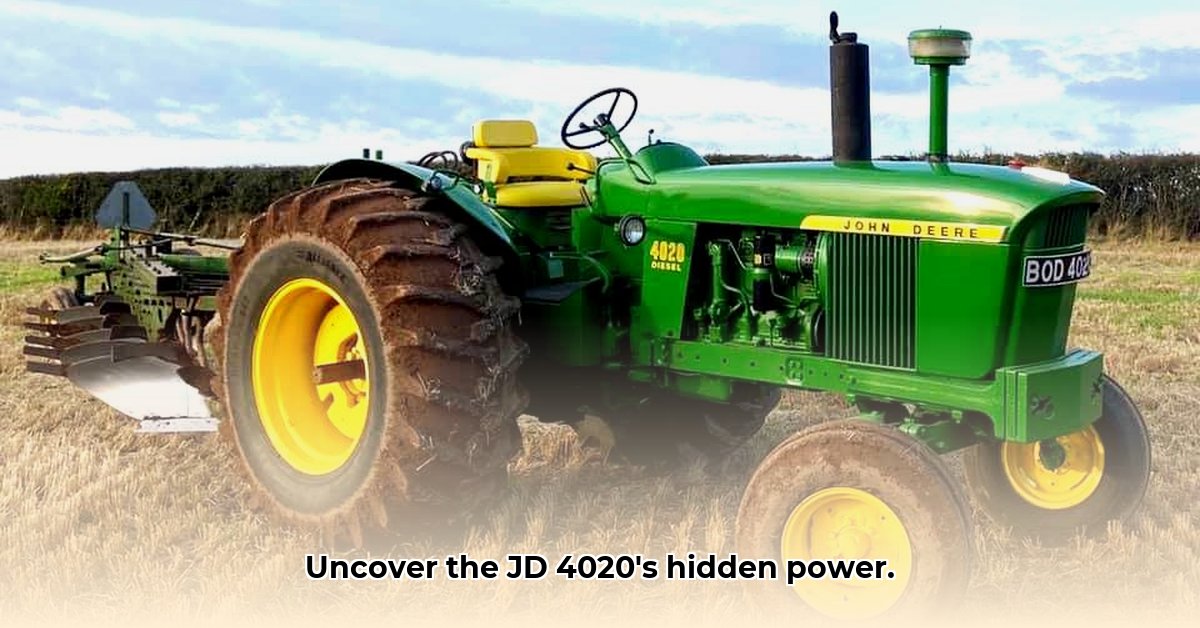
The John Deere 4020: a legend in the agricultural world. This iconic tractor, produced from 1963 to 1972, remains a popular choice for collectors and farmers alike. This comprehensive guide delves into its specifications, history, and maintenance, providing essential information for potential buyers and restoration enthusiasts. Whether you're a seasoned collector or a curious newcomer to the world of vintage tractors, this guide offers valuable insights. For even more details, check out this dedicated 4020 resource.
Powertrain: Engine Options and Performance
The JD 4020 offered a choice of engines: gasoline, diesel, and LP gas. Each engine type presented a unique balance of power, fuel efficiency, and maintenance requirements.
Gasoline: These engines provided a spirited performance, ideal for short bursts of high-power tasks. However, they generally exhibited lower fuel efficiency compared to diesel counterparts. Maintenance is relatively straightforward.
Diesel: The diesel engine, famed for its fuel efficiency, was the workhorse option. Its steady power output made it perfect for long hours of operation, though it usually offered slightly less peak horsepower than the gasoline engine. Maintenance is more complex.
LP Gas: Offering a middle ground between gasoline and diesel, the LP gas engine provided moderate power and fuel efficiency. Maintenance needs fell between those of gasoline and diesel engines. The availability of LP gas fueling might be a limiting factor for some owners.
Engine Specs Comparison:
| Engine Type | Horsepower (PTO) | Fuel Efficiency | Maintenance Complexity | Ideal Application |
|---|---|---|---|---|
| Gasoline | 97 hp | Lower | Simple | Short bursts of high power |
| Diesel | 95 hp | Higher | Complex | Long, steady operation |
| LP Gas | 97 hp | Moderate | Moderate | Balanced power & efficiency |
Isn't it fascinating how the engine choice significantly impacted the overall performance and usability of the 4020? Choosing the right engine boils down to prioritizing your specific needs.
Transmission: Shifting Gears for Efficiency
The JD 4020 featured two primary transmission options: Syncro-Range and Power Shift. Both offered distinct operating characteristics and advantages.
Syncro-Range: This manual transmission provided precise control over gear selection, ideal for operators who prefer a hands-on approach. It's known for its smooth operation and relative simplicity.
Power Shift: Offering faster gear changes under load, the Power Shift transmission enhanced productivity, especially during repetitive tasks. It simplified operation and reduced operator fatigue.
The choice between these transmissions hinges on individual preferences and operational demands. Do you prefer the precision of manual shifting or the convenience of power shifting? This question is key to selecting the right 4020 for your needs. Approximately 184,879 units of the 4020 were produced overall during its production run, a substantial number showing its popularity.
Model Variations and Optional Features
John Deere offered the 4020 in various configurations to cater to diverse applications:
- Standard: A versatile model suitable for a broad range of tasks.
- Row-Crop: Designed with a narrower front end for operation between closely spaced crop rows.
- High-Crop: Featured increased ground clearance for working among taller crops.
- Industrial: Built for demanding industrial applications beyond agriculture.
Many 4020s were equipped with the optional front-wheel assist, which significantly enhanced traction in challenging conditions. This option greatly improved the tractor's versatility and maneuverability, especially in wet fields. Choosing the right variant is critical for optimizing the tractor's performance in your specific farming or industrial setting.
Historical Context: A Legacy of Innovation
The JD 4020's production run (1963-1972) coincided with significant advancements in agricultural technology. Its robust design, powerful engine options, and diverse configurations played a pivotal role in shaping farming practices for a generation. The 4020’s popularity reflects its reliability and adaptability, solidifying its position as a true classic. Its impact resonated far beyond its production years.
Maintenance and Restoration: Caring for a Classic
Maintaining and restoring a JD 4020 requires dedication and expertise. Sourcing parts may present a challenge due to the tractor's age, but online communities and specialized suppliers offer assistance. Restoration is a labor-intensive process, demanding both mechanical skills and financial resources. However, the reward of owning and operating a meticulously restored 4020 is immeasurable. Many owners find immense personal satisfaction in this undertaking.
Modern Relevance and Niche Uses
While not a modern tractor, the JD 4020 retains relevance in specific contexts. Its straightforward mechanical design and sturdy construction make it ideal for smaller farms or those seeking a reliable, low-maintenance machine. Its simplicity can be an advantage in situations where complex electronics are unnecessary or undesirable. Furthermore, its robust build continues to stand the test of time.
Conclusion: A Lasting Legacy
The John Deere 4020 represents more than just a tractor; it’s a symbol of agricultural innovation and enduring reliability. Its versatility, various engine and transmission options, and numerous model variations solidified its place in history. For buyers and collectors alike, understanding its specifications, history, and maintenance requirements is key to appreciating its lasting legacy.
Resources
- Yesterday's Tractors Forum (Example; replace with a relevant and active forum)
- John Deere Manuals (Example; replace with a specific page if available)